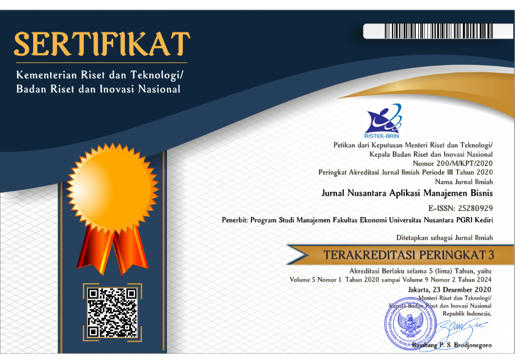Eksplorasi Perencanaan Keuangan Generasi Muda: Pendekatan SEM PLS
DOI:
https://doi.org/10.29407/nusamba.v10i1.22140Keywords:
financial planning, young genereation, financialAbstract
Research aim: This study aims to reveal the financial planning actions taken by the younger generation. The factors taken to measure the financial planning of the younger generation are Financial Literacy, Trust, FOMO, and Mental Accounting.
Method: This research uses a quantitative method, where researchers use numbers based on a Likert scale to answer the hypothesis proposed. The data collection method in this research uses non-probability sampling or voluntary sampling techniques. After distributing the questionnaires, a sample size of 140 respondents was obtained. The sample obtained was then analyzed using statistical software, namely Smart PLS 4.0.
Research Finding: The findings obtained in this research are that the independent variables, namely financial literacy, trust, and fomo, have a positive and significant impact on the financial planning of the younger generation. Meanwhile, one other variable, namely mental accounting, has no effect on individual financial planning in the younger generation. When viewed from the impact of the existing correlation of the independent variable on the dependent variable, it has a value of 55.2 percent. The rest may be influenced by other variables that were not tested in this study.
Theoretical contribution: This research contributes to the tendencies that can cause an individual to be influenced in deciding financial actions.
Practitionel implication : Financial literacy, self-confidence, and mental accounting have an impact on individuals when doing financial planning. So that individuals must be able to protect themselves by understanding the factors that drive their decision making. The findings in this research can be taken into consideration in decision making by the government regarding financial education to the public. Apart from that, the findings from this research can also be input for financial service providers to provide understanding to users before using their financial products.
Research limitation : This research was only conducted on the younger generation, namely the generation born between 1997 - 2010 or commonly known as generation Z. Therefore, these results cannot be used to make judgements about millennials or other generations. So these results cannot properly be an assessment of millennial society or other generations.
Downloads
References
Daftar Pustaka
[1] Niswah FM, Mutmainah L, Legowati DA. Muslim Millennial ’ S Intention of Donating for. J Islam Monet Econ Financ 2019;5:623–44.
[2] Anwar AI. Perilaku Keuangan Generasi Z. WwwTvUnhasAcId 2023. https://tv.unhas.ac.id/perilaku-keuangan-generasi-z/.
[3] Hidayat F, Siregar SR, Nugroho AW. Efek Financial Management Behavior , Self Efficacy , Herding Terhadap Keputusan Investasi Generasi Z ( Effects of Financial Management Behavior , Self-Efficacy , Herding on Generation Z Investment Decisions ). J Akuntansi, Bisnis Dan Manaj 2023;30:61–72. https://doi.org/https://doi.org/10.35606/jabm.v30i1.1192.
[4] Vittengl JR. Low household income, financial literacy, or financial health: Which is the strongest risk factor and outcome of depressive symptomatology? J Affect Disord 2024;344:18–24. https://doi.org/10.1016/j.jad.2023.10.019.
[5] Gupta S, Shrivastava M. Herding and loss aversion in stock markets: mediating role of fear of missing out (FOMO) in retail investors. Int J Emerg Mark 2022;17:1720–37. https://doi.org/10.1108/IJOEM-08-2020-0933.
[6] Adow AHA. Can orientation towards finance and perceived financial literacy lead to intention towards investment? An examination using structural equation modeling. Uncertain Supply Chain Manag 2024;12:1–8. https://doi.org/10.5267/j.uscm.2023.11.001.
[7] Aryan LA, Alsharif A, Alquqa EK, Al Ebbini MM, Alzboun N, Alshurideh MT, et al. How digital financial literacy impacts financial behavior in Jordanian millennial generation. Int J Data Netw Sci 2024;8:117–24. https://doi.org/10.5267/j.ijdns.2023.10.011.
[8] Aman H, Motonishi T, Ogawa K, Omori K. The effect of financial literacy on long-term recognition and short-term trade in mutual funds: Evidence from Japan. Int Rev Econ Financ 2024;89:762–83. https://doi.org/10.1016/j.iref.2023.10.006.
[9] Safari K, Njoka C, Munkwa MG. Financial literacy and personal retirement planning: a socioeconomic approach. J Bus Socio-Economic Dev 2021;1:121–34. https://doi.org/10.1108/jbsed-04-2021-0052.
[10] Yeo KHK, Lim WM, Yii KJ. Financial planning behaviour: a systematic literature review and new theory development. J Financ Serv Mark 2023. https://doi.org/10.1057/s41264-023-00249-1.
[11] Godase R, P J, Supriya ML. Financial planning propensity in working adults: exploring the role of media. Manag Financ 2024;50:313–28. https://doi.org/10.1108/MF-04-2023-0253.
[12] Joshi M. Is phubbing due to social media impacting my well-being – demystifying the FOMO, CSMU, phubbing loop among school and university cohorts. Kybernetes 2023. https://doi.org/10.1108/K-03-2023-0456.
[13] Suherman S, Kurniawati H, Mohidin R. Determinants of financial risk tolerance: Evidence from the Indonesian millennials. Humanit Soc Sci Lett 2023;11:67–82. https://doi.org/10.18488/73.v11i1.3300.
[14] Usriyono E, Wahyudi S. the Investment Decision of Millennial Generation: an Analysis Using Financial Literacy and Financial Behavior. Corp Gov Organ Behav Rev 2023;7:8–14. https://doi.org/10.22495/cgobrv7i2p1.
[15] Cengiz H, Şenel M. The effect of perceived scarcity on impulse-buying tendencies in a fast fashion context: A mediating and multigroup analysis. J Fash Mark Manag 2023. https://doi.org/10.1108/JFMM-03-2023-0082.
[16] Guzman F, Paswan A, Tripathy N. Consumer centric antecedents to personal financial planning. J Consum Mark 2019;36:858–68. https://doi.org/10.1108/JCM-01-2018-2514.
[17] Mahapatra MS, Raveendran J, Mishra RK. Role of Mental Accounting in Personal Financial Planning: A Study Among Indian Households. Psychol Stud (Mysore) 2022;67:568–82. https://doi.org/10.1007/s12646-022-00683-6.
[18] Muehlbacher S, Kirchler E. Individual Differences in Mental Accounting. Front Psychol 2019;10:1–15. https://doi.org/10.3389/fpsyg.2019.02866.
[19] Putro TR, Sumantyo R, Sulistio H, Sriwiyanto JN. Model Dan Strategi Pentingnya Perencanaan Keuangan Untuk Menghadapi Masa Pensiun Pada Era Industrialisasi 4.0 Di Kota Surakarta. J Kuat Keuang Umum Dan Akunt Terap 2022;4:129–33.
[20] Harahap S, Thoyib A, Sumiati S, Djazuli A. The Impact of Financial Literacy on Retirement Planning with Serial Mediation of Financial Risk Tolerance and Saving Behavior: Evidence of Medium Entrepreneurs in Indonesia. Int J Financ Stud 2022;10. https://doi.org/10.3390/ijfs10030066.
[21] Salleh MCM, Chowdhury MAM, Nasarudin AFBM, Ratnasari RT. The impact of cognitive factors on individuals’ financial decisions. Manag Account Rev 2020;19:69–88. https://doi.org/10.24191/mar.v19i03-04.
[22] Maharani NK, Sari IM. Can financial literacy and asset ownership affect retirement planning? Insights from the Indonesian family life survey. J Account Invest 2023;24:828–40. https://doi.org/10.18196/jai.v24i3.16112.
[23] Nur Assyifa C, Subagyo H. Pengaruh Literasi Keuangan dan Gaya Hidup Terhadap Perencanaan Keuangan Pegawai Kantoran di Tangerang Raya. J Econ Bus UBS 2023;12:1149–66. https://doi.org/10.52644/joeb.v12i2.195.
[24] Mendari AS, Soejono F. Hubungan Tingkat Literasi Dan Perencanaan Keuangan. Modus 2019;31:227–40.
[25] Reddy CD. Entrepreneurial decisions: viewing the affordable loss heuristic from an economic well-being perspective. Int J Entrep Behav Res 2023;29:170–83. https://doi.org/10.1108/IJEBR-07-2022-0612.
[26] Hair JF, Hult GTM, Ringle CM, Sastedt M. A primer on partial least squares structural equation modeling (PLS-SEM). vol. 38. 2017. https://doi.org/10.1080/1743727x.2015.1005806.
[27] Subaki A, Sumarso S, Tohari T, Hidayat F. Determinasi Whistleblowing Intention Melalui Sikap Ethical Awareness Dan Ethical Judgement. Value J Manaj Dan Akunt 2023;18:581–90. https://doi.org/10.32534/jv.v18i2.4279.
[28] Moshood TD, Nawanir G, Mahmud F, Ahmad MH bin, Mohamad F, AbdulGhani A. The plastic of the future: determinants for switching intention from synthetic to biodegradable plastics among the young consumers. J Soc Mark 2023;13:121–48. https://doi.org/10.1108/JSOCM-05-2022-0097.
[29] Murugiah L, Ismail R, Taib HM, Applanaidu SD, Long MNHBH. Children’s understanding of financial literacy and parents’ choice of financial knowledge learning methods in Malaysia. MethodsX 2023;11:1–12. https://doi.org/10.1016/j.mex.2023.102383.
[30] Lone UM, Bhat SA. Impact of financial literacy on financial well-being: a mediational role of financial self-efficacy. J Financ Serv Mark 2022;29:122–37. https://doi.org/10.1057/s41264-022-00183-8.
[31] Dare SE, van Dijk WW, van Dijk E, van Dillen LF, Gallucci M, Simonse O. How Executive Functioning and Financial Self-efficacy Predict Subjective Financial Well-Being via Positive Financial Behaviors. J Fam Econ Issues 2022;44:232–48. https://doi.org/10.1007/s10834-022-09845-0.
Downloads
Published
Issue
Section
License
Copyright (c) 2025 Akhmad H Abubakar, Ahmad Subaki, Faizal Ridwan Zamzany, Fikri Hidayat

This work is licensed under a Creative Commons Attribution-ShareAlike 4.0 International License.
Authors who publish with this journal agree to the following terms:
- Copyright on any article is retained by the author(s).
- The author grants the journal, the right of first publication with the work simultaneously licensed under a Creative Commons Attribution License that allows others to share the work with an acknowledgment of the work’s authorship and initial publication in this journal.
- Authors are able to enter into separate, additional contractual arrangements for the non-exclusive distribution of the journal’s published version of the work (e.g., post it to an institutional repository or publish it in a book), with an acknowledgment of its initial publication in this journal.
- Authors are permitted and encouraged to post their work online (e.g., in institutional repositories or on their website) prior to and during the submission process, as it can lead to productive exchanges, as well as earlier and greater citation of published work.
- The article and any associated published material is distributed under the Creative Commons Attribution-ShareAlike 4.0 International License












